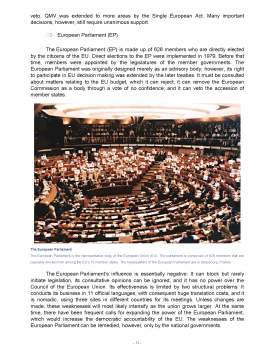Extras din referat
I INTRODUCTION
European Union (EU), organization of European countries dedicated to increasing economic integration and strengthening cooperation among its members. The European Union headquarters is in Brussels, Belgium.
The European Union was formally established on November 1, 1993. It is the most recent in a series of European cooperative organizations that originated with the European Coal and Steel Community (ECSC) of 1951, which became the European Community (EC) in 1967. The members of the EC were Belgium, Denmark, France, Germany, Greece, Ireland, Italy, Luxembourg, The Netherlands, Portugal, the United Kingdom, and Spain. In 1991 the governments of the 12 member states signed the Treaty on European Union (commonly called the Maastricht Treaty), which was then ratified by the national legislatures of all the member countries. The Maastricht Treaty transformed the EC into the EU. In 1994 Austria, Finland, and Sweden joined the EU, bringing the total membership to 15 nations.
Members of the European Union
The European Union (EU) was established in 1993 by the 12 nations of the European Community. The EU works toward better political and economic integration and cooperation between member nations. Austria, Finland, and Sweden joined the EU in 1994.
Flag of the European Union
The flag of the European Union (EU) is composed of a circle of 12 gold stars on a royal blue background. The flag is meant to represent the union of all the peoples of Europe.
The EU has a number of objectives. Primarily, it works to promote and expand cooperation among its members in several areas, including economics and trade, social issues, foreign policy, security, and judicial matters. Another major goal has been to implement Economic and Monetary Union (EMU), which established a single currency for EU members. With the exception of EMU, which went into effect in 1999, progress toward these goals has been erratic. The EU’s ability to achieve its goals has been limited by disagreements among member states, external political and economic problems, and pressure for membership from the new democracies of Eastern Europe.
II HISTORY OF THE EUROPEAN UNION
The dream of a united Europe is almost as old as Europe itself. The early 9th-century empire of Charlemagne covered much of western Europe. In the early 1800s the French empire of Napoleon I encompassed almost all of the European continent. During World War II (1939-1945), Adolf Hitler nearly succeeded in uniting Europe under Nazi domination. All these efforts failed because they relied on forcibly subjugating other nations rather than cooperating with them.
Attempts to create cooperative organizations fared little better until after World War II. Until that time, nations had strongly opposed all attempts to infringe on their powers and were unwilling to give up any control over their policies. These early organizations were international or intergovernmental organizations that depended on the voluntary cooperation of their members; consequently, they had no direct powers of coercion to enforce their laws or regulations. Supranational organizations, on the other hand, require their members to surrender at least a portion of their control over policy areas and can compel compliance with their mandates. After World War II, proposals for some kind of supranational organization in Europe became increasingly frequent.
A Early Cooperation
Postwar proposals for a European supranational organization had both political and economic motives. The political motive was based on the belief that only a supranational organization could eliminate the threat of war between European countries. Some supporters of European political unity, such as the French statesman Jean Monnet, further believed that if the nations of Europe were to resume their dominant role in world affairs, they had to speak with one voice and have at their command resources comparable to those of the United States.
The economic motive rested on the argument that larger markets would promote increased competition and thus lead to higher productivity and standards of living. Economic and political viewpoints merged in the assumptions that economic strength was the basis of political and military power, and that a fully integrated European economy would make conflicts between European nations less likely. Because many countries were concerned about giving up any control over national affairs, most of the practical proposals for supranational organizations assumed that economic integration would precede political unification.
Preview document
Conținut arhivă zip
- European Union.doc

































